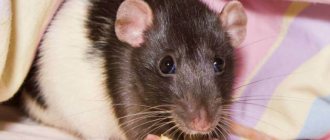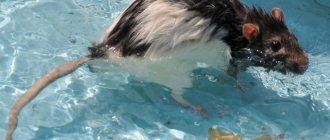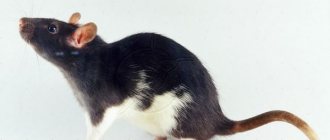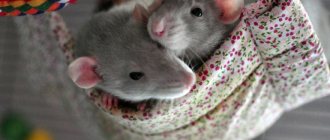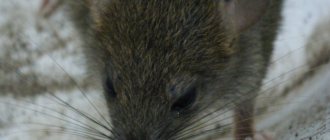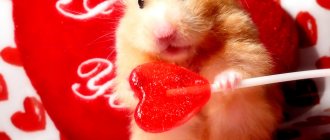Decorative rodents have been living with humans for quite a long time.
Different breeds of rats, or rather their varieties, differ in head and body shape, coat structure and color. Exotic species require special care because they are more vulnerable. It is worth understanding what kinds of decorative rat breeds there are. Let's look at the breeds of rats with photographs and names, and make sure that the fixed mutations are very diverse, for every taste.
What types of domestic rats are there?
Rodent species standards are set by many organizations around the world.
We will focus on the AFRMA Fancy Rats classification of the American Rat and Mouse Association. Rodents come in white, black, brown, gray and beige. There are more than 15 color options in total AFRMA Fancy Rats - Self. Sometimes spotted individuals are found. The eyes of animals can be black, ruby, or red. When determining a variety, these characteristics are usually not taken into account. Experts look at the shape of the ears, the structure of the tail, and the presence and type of fur.
There are seven varieties of AFRMA Fancy Rats in total.
Rat standard
The animal's fur AFRMA Fancy Rats - Varieties tightly covers the body and shines. It should be short and smooth. Males have slightly longer and stiffer hairs than females.
Photo: alexeisido/Shutterstock
Rex rat
This species has curly hairs on its body. The coat should be thick and soft. Curly whiskers are normal for these rodents.
Photo: Colin Seddon/Shutterstock
Tailless rat
Such animals can have any color and coat structure. The main feature is the absence of a tail.
Photo: George Dolgikh/Shutterstock
Sphinx
These rats are hairless. They have thin, almost transparent skin. It can be pink, gray or spotted. Normally, there are no scars or pimples on it, but wrinkles are allowed. The ears are large and smooth. The mustache is usually short and curly. Although they may not exist at all.
Photo: RaulRamirez/Shutterstock
Satin, or satin, rat
The fur of these animals is long, straight and fine. It may appear to be sparkling. The hair is pleasant to the touch. The mustache is usually wavy.
Photo: Sergey Bezgodov / Shutterstock
Dumbo Rat
A distinctive feature of the variety is its large round ears. They are set low on the sides of the head. But the wool can be any kind.
Photo: JLRphotography/Shutterstock
Bristle rat
These rodents have slightly wavy fur. With age she becomes rougher and straighter. It feels like a metal brush. The mustache can be straight or wavy at the tips.
Photo: Carlos Aranguiz/Shutterstock
Division of colors
Color is the color or shade of the fur of a decorative rat. Currently, there is a fairly large number of shades, and they are all divided into uniform, ticked and combined, silver and marked:
- Uniform colors are when all the hairs are the same color and tone. For example, black - the coat is black from root to tip. The undercoat is extremely dark. There may be other colors - blue, Russian blue, smoky blue.
- Ticked colors. Ticking is uneven hair coloring. In other words, there are zones on the wool that are colored in different colors. Among these non-standardly colored hairs, guard hairs of the same tone are identically interspersed. Agouti-colored rats are ticked.
- Silver color is absolutely any of the generally recognized colors. They can be uniform and ticked. Their main feature is the periodic repetition of silver and colored hairs in the same amount. All silver hair should be mostly white, although it is acceptable to have a colored tip. The skin of such an animal gives the impression of shine and sparkle. If few white hairs are observed, the color is not recognized as such. In order not to confuse the silver color with pearl, the silver color should be clearly expressed.
- Combined colors are a combination of several colors. All shades can participate, with the exception of white. Multicolor extends to the entire body of the rodent in accordance with the standard. This includes Siamese colors - Siamese and Himalayan.
- Marked - a combination of white and colored areas of the hair. And marking is a pattern that involves a certain combination of white and colored areas.
A direct relationship has been established between the color of the hair coat and the color of the eyes of the animal. The shade of the eyes directly depends on the color of the coat. Quite often, white rats have red or black eyes.
When breeding ornamental animals with certain qualities, it is imperative to take into account the laws of genetics. It must be borne in mind that color, coat texture and a number of other physical characteristics are inherited by rats according to the general, well-known law of heredity.
What is the character of domestic rats?
Rodents are attached to their owners. They are recognized by their voice 5 reasons why you'd love a pet rat! and appearance. Animals enjoy Rat Personality, Intelligence, and Care when owners scratch them behind the ears, pet them, and massage their backs. At such moments, rats often begin to chatter their teeth. This means that the pet is happy. Some animals “look after” their owners: they lick and gently bite their hands.
When humans are not around, rodents need the company of their own kind. Animals enjoy playing together and cleaning each other.
It is better to keep rats in same-sex pairs Caring for your rat. Otherwise, they will often bear offspring: there are eight cubs in a litter.
Females are active and mischievous. They love to explore new places and run. Males are a little calmer. They can sit relaxed in their owner's arms while he watches TV.
Rodents are very smart. They quickly learn to call and perform simple Rats tricks! The Perfect Pet? . For example, jumping through a hoop or playing with a ball.
Remember: Rats sometimes bite Rats! The Perfect Pet? . This can happen if there are cubs in the home, a stranger has stuck a finger into the cage, the owner’s hands smell of food, or the animal is scared because it was suddenly picked up. Therefore, wash your hands before touching a rodent. Don't tease him with food. Be careful if there are babies in the cage. Try not to remove animals from their home too quickly. First, say something to the rat, pet it. If your pet is scared or injured, wrap it in a towel. Only then take him out of the cage. Hold your pet every day. Otherwise, it will lose the habit and stop trusting you.
Markings for this color
A husky rat can only be one of two available markings:
- Berkshire Husky.
- Banded Husky.
The Berkshire Husky is a coat type marking with a white belly and colored rat back. The head, like the back, is also colored.
Banded Husky is a "hood" type marking where the animal's head, chest and shoulders are evenly colored. The exception is Blaze. From the so-called hood, a strip of dyed wool runs along the back. In this marking, such a stripe is very wide.
What living conditions are required for decorative rats?
It is best to place the rat in a spacious wire cage Caring for your rat. Height - no less than 50 cm, minimum floor area - 50 × 80 cm. The flooring must be hard and even, for example plastic. The option with rods will not work: the animal may damage its paws.
Photo: borisenkoket/Shutterstock
There are several rules for placing a house. Rodents are susceptible to cold and heat. They feel best at a temperature of 20 degrees. Therefore, the cage is usually placed away from direct sunlight, radiators and drafts. If there are other animals in the house, then the home should be, for example, on the Rat: Species Profile nightstand or table.
A nipple drinker and bowls must be placed inside the cage. If desired, you can buy a tray and filler for rodents. The rat should also have a shelter: a hammock or a house.
Photo: Bilanol/Shutterstock
Rodents love toys very much. For entertainment, owners choose running wheels, tunnels, platforms and wooden figures. The latter should be changed regularly, otherwise the animal will get bored.
Rats like to make nests. Therefore, you can periodically put paper in the cage. Remember that newspaper sheets will not work. The ink can cause poisoning to your pet.
Cell selection
In order for your pet to feel great, you need to purchase a spacious cage with a set of all the necessary accessories and balanced food. You should always remember that the cage for a fluffy rat plays a very important role, since he spends most of his life in it. Therefore, when choosing a cage, you should be guided by the following requirements.
Cage dimensions
It is not recommended to keep your pet in a cramped cage, as the animal likes to move a lot. As a rule, the optimal cage dimensions are within the following limits: cage width – 40 cm, cage length – 60 cm and cage height – also 60 cm. For such an animal, this space is absolutely enough. The distance between the cage bars should be no more than 1.2 cm.
bottom of the cage
For such rodents, a solid floor is more suitable, since a lattice floor leads to injuries to the rodents’ limbs.
Cage tray
The starting material for the pallet is durable plastic. The pallet should have high sides to prevent the filler from spilling out. The pallet should not be made of wood, since wood will absorb urine, which will cause an unpleasant odor in the home.
Cage design
The best option is a collapsible cage with large doors to make it convenient to clean, wash, feed and hang various elements. The cage must have shelves for animals to rest.
Cage coating
As a rule, cage rods are coated with enamel, zinc or powder paint, which is not critical. The main thing is that the coating is of high quality, without chips or rust.
What to feed pet rats
These rodents are omnivores. What should I feed my pet rat? , but you still need to control their diet. The simplest food option is dry balanced food. These are sold in pet stores. Before purchasing, you should carefully study the composition. The protein content should be at least 16%, fat - 4-5%.
The diet can be varied with vegetables and fruits. Pears, apples, bananas, melons, broccoli, cabbage, carrots, celery and peas are considered safe.
Treats you can give your rat are grains, grains, seeds, bread, cookies, sweets and breakfast cereals. But you shouldn’t treat your rodent with them too often.
Here's what you should absolutely not give to pet rats:
- blue cheeses;
- green bananas;
- raw potatoes and their skins;
- licorice;
- Orange juice;
- mango;
- raw artichokes;
- avocado;
- raw beans and peanuts;
- rhubarb;
- raw red cabbage and Brussels sprouts;
- dried fruits;
- peanut butter.
Regardless of what is in the bowl, the rodent should always have clean, fresh water in the bowl.
Description of appearance
These animals are unique mainly because of their curly coat. Otherwise they look like other breeds.
It is not difficult to recognize Rex by his appearance. Healthy purebred animal:
- The coat is thick and curly, without bald spots or rosettes;
- The curls on the coat are springy;
- the muzzle is wide and blunt;
- The ears are large and widely spaced;
- fluffy tail.
How to care for a decorative rat
There are several tips that will help make your rodent's life more comfortable.
Get out of the cage
The pet needs cleanliness. If the home is dirty, the animal may develop a Cleaning Your Pet Rats' Cage lung infection.
Once a day, remove feces from the tray or corner that the animal has chosen as a toilet. Lightly wipe the cage with a damp cloth.
If there is litter, replace it with fresh litter every week. Remove toys and bowls from the cage. Treat them with a non-toxic disinfectant spray. It is sold in pet stores. After this, you should rinse the accessories with hot water, dry them and put them back.
General cleaning of the home is carried out once a month. Repeat the same things you do every day and once a week. Then disassemble the structure and spray with an antibacterial agent. Rinse with water and dry.
Let the rat out of the cage
The rodent should run and play outside the cage for at least an hour a day. The room in which the animal spends time needs to be prepared Caring for your rat. Close windows and doors before letting your pet out. If there are gaps in the floor, between the baseboards and the walls, plug them with something. Remove plants and wires.
Trim your claws
This procedure must be carried out Rat: Species Profile once every two months. You will need special scissors for this. You can buy them at a pet store.
Photo: Vector Up / Shutterstock
To do everything right, hold the claw up to the light. You will see a translucent tip, this is what you need to cut off. Just above this process is the pink part. These are blood vessels and nerve endings; they cannot be touched. If damaged, the animal will be in pain and will bleed. If this happens, apply some cornstarch to the wound.
Bathe the rat
Usually the animal cleans its fur with its paws. Normally it shouldn't smell bad. If a strong smell appears, it means that the cage has not been cleaned for a long time or the rodent is sick.
The animal needs to be washed How to Bathe Your Pet Rat Without Stress in extreme cases. For example, if chewing gum or other unsafe substance is stuck to the hairs. For the procedure you will need warm water, special shampoo from a pet store and a towel. While bathing, the animal must be held: rats do not like water.
The main rule is not to wet your head and eyes.
If your pet really doesn’t like the process, treat him to a piece of apple or pear. This will distract the animal from unpleasant emotions.
Predators in nature
As a rule, in urban areas you can most often find ordinary rats. They may have a gray, sometimes black skin color. The colors of rats in nature range from grayish to red. Sometimes you can find a brown rodent.
The most common types of rat colors in nature:
- Gray rat. Young animals have gray fur. When they mature, they acquire a reddish tint. On the abdomen, white hairs have a dark base.
- Black rat. On the back, the color of the skin has a greenish tint. The belly has dark gray or ash-colored hairs.
- Small rat. It has a brown skin color.
In central Russia, there are mostly two types of rats: black and gray.
What do domestic rats suffer from?
Most rodents do not suffer from any disorders during their lives. But you still need to monitor your pet’s condition. Sometimes animals develop the following abnormalities Keeping your rat happy and healthy:
- Tumors. Females and all older individuals are at risk. Most often, the tumor can be removed.
- Parasites: ticks and fleas. The main symptoms are itching and rash. You may need a medicated shampoo.
- Too long teeth. They grow back if the animal does not grind them off on hard vegetables or wooden toys. This makes it difficult for rats to eat and drink.
- Respiratory diseases. A rodent can be a carrier of mycoplasma, which lives in the respiratory system. The microorganism leads to a fatal infection. The disease is identified by red spots on the nose and around the eyes, sneezing and wheezing.
- Obesity. Excess weight can cause your pet to have problems with its paws. Life expectancy is decreasing. To avoid deviation, you need to exclude fatty and sweet foods.
In order to notice violations in time, the rat should be examined every day. Normally, there are no bumps on the body, the fur is smooth and shiny, and the rodent has a good appetite.
If you notice any changes, take your pet to the veterinarian.
There are diseases that are dangerous not only for rodents, but also for humans. According to the American Veterinary Medical Association, domesticated rats sometimes infect They're intelligent and friendly. Why some people think rats are the perfect pet, for fun and comfort. people with leptospirosis, salmonellosis and fever. These abnormalities are almost never seen, and people rarely die from them.
To avoid catching a disease from a rat, you should try to avoid bites and wash your hands immediately after contact with the animal. If the animal does bite you, wash the wound with warm water and soap. Dry with a towel, apply antibiotic cream or ointment, and apply a bandage for a short time.
Social structure and reproduction
Photo: Male and female Dumbo
The vitality and growth rate of the rat population has become a household name - in nature, rodents reproduce several times a year. Ornamental dambiks are also quite prolific, however, to breed these animals, owners will need to select a healthy pair with pronounced characteristics of the species. These are: a pear-shaped short body and a long narrow tail, as well as a wide flattened head with large round ears.
The first mating of a female should occur at 5-7 months. Pregnancy in Dumbo rats lasts 21-23 days. One litter usually produces 9-12 adorable babies. Dumbo rat pups are born blind and deaf with a naked body. Moreover, not all newborns may have large, round ears - this species characteristic is difficult to preserve. The individual development of babies occurs very quickly. At 4 days of age, they already begin to hear; at 12 days, dambiks open their small eyes. At the age of 2 weeks, the offspring of Dumbo rats are already actively studying their owners and learning about the world around them.
It is very important for the owner of a Dumbo rat to remember that this charming rodent is a social animal. It is very important to provide your pet with communication with both relatives and humans. Systematically conducted outdoor games with this animal, the affectionate formation of precious trust and reverent love - dambiks become attached to only one person for life. Smart rodents have no trouble mastering simple tricks, fetching small objects, finding treats, and even jumping over barriers. Training brings a lot of pleasure to both animals and humans.


